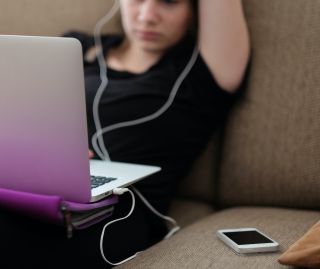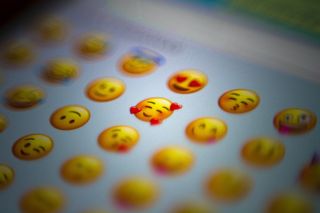Social Media
Is Adolescent Digital Media Use Linked to Anxiety?
The pivotal role of emotion regulation in an online world.
Posted January 14, 2024 Reviewed by Tyler Woods
Key points
- Adolescents’ social worlds are embedded in digital media.
- Empirical findings linking digital media and anxiety are mixed, but teens and parents express concern.
- Research focuses on: Who is at risk? How do teens use digital media? How do patterns relate how youth feel?
- Emotion regulation difficulties may explain why digital media use is associated with anxiety symptoms.

By guest author Sarah Myruski.
Adolescents’ social world is a critical context for development. Across generations, interactions with peers drive exploration of the key tasks of adolescence, including identity formation, expanding autonomy from caregivers, and striving toward emotional maturity. However, the modern social landscape has been transformed by digital media, defined as any technology-based platform that allows for social interaction and/or individual broadcasting of content, including social media, texting apps, and online gaming platforms (Steele et al., 2020).
Digital media is qualitatively different from in-person interactions in many ways (Nesi et al., 2018), including asynchronicity, facilitating near-constant availability, and the frequent absence or ambiguity of non-verbal social-emotional cues.
Psychologists, parents, and adolescents themselves have widely expressed concern regarding how digital media relates to adolescent well-being. Of particular interest for our research team, adolescence is marked by peaked anxiety symptom onset (i.e., one in three teens experience distressing and impairing levels of anxiety by age 18). However, research findings on the links between digital media use and anxiety have been mixed, highlighting the importance of examining the nuances of individual vulnerabilities and patterns of online and offline social behavior.
Our research team recently been focusing on how and why teens use digital media, not just frequency of use. In particular, we ask teens about their preferences to communicate using technology as opposed to face-to-face interactions. For instance, we ask teens which they prefer when they are sharing their feelings or when they are catching up with friends. We’ve found that some teens strongly prefer using digital media over face-to-face opportunities. This preference could be driven by the fact that online platforms offer greater controllability than in-person interactions—it’s easier to plan out what to say, we have time to consider our responses and curate how we present ourselves to others.
Importantly, people with emotion regulation difficulties may find these features of digital media particularly appealing. Emotion regulation is a range of abilities, including how we detect emotional cues, the extent to which we can flexibly increase or decrease the intensity of our emotions, as well as choosing when and how to express emotions. We know from decades of research that difficulties with emotion regulation underlie elevated anxiety in youth, and emotion regulation capacity in the brain also undergoes profound development during adolescence. Our emotion regulation abilities are shaped and improved through practice, through habitual social interactions during which we express our thoughts and emotions. Thus, too few face-to-face experiences may get in the way of getting better at emotion regulation.

In a recent study of adolescents (ages 12-15), we examine social interaction preferences and relations with adolescents’ emotions, their regulation, and anxiety. We use electroencephalography (EEG) to capture connectivity between brain regions involved in emotion regulation—specifically the “emotion control” areas in the cortex of the brain, and “emotion generating” areas deeper in the brain, below the cortex, or “subcortical.” When teens’ pattern of brain activity signaled “over-control” of emotions, we found that a greater preference for digital media for social-emotional communication predicted elevated social anxiety symptoms. One might think that when it comes to neural control over emotions, more is always better. However, this is not always the case in our research and others (e.g., Poole et al., 2020). Among “digital-preference” teens, we think this heightened connectivity may reflect neural rigidity, which could result in a heightened need for control in unpredictable social situations. Indeed, intolerance of uncertainty and avoidance of new situations or people are hallmarks of social anxiety.
In sum, our research points to the interpretation that difficulties with emotion regulation may put some teens at risk for the downsides of digital media use. Teens who habitually prefer digital media may miss out on opportunities to hone social skills and get practice managing emotions in real-time interactions. Based on this recent and ongoing research, we seek to inform healthy technology use for adolescents and their parents, and our work underscores the recommendations put forth by the APA.
First, we should encourage a balance between digital media use and face-to-face interactions. We use the term "balance" rather than the harsher "restrictions" since engagement in online life for teens has become a pillar of youth social circles. High levels of restriction could increase stress and anxiety and social consequences of not being an available and supportive friend. What may be more realistic and helpful is equipping teens with the tools to manage worry about disappointing friends, and building social skills to set and maintain boundaries they themselves are comfortable with, all of which are components of “digital literacy”. Second, sometimes in-person interactions are not possible—in those instances, it may be best to opt for forms of digital communication that include real-time social cues (such as voice calls or FaceTime) because those more closely resemble in-person interactions.
Finally, since our evidence highlights the pivotal role of emotion regulation, we can seek ways to practice emotion regulation through everyday activities like talking through emotions, journaling, artistic expression, and/or through interventions specifically designed to bolster emotion regulation (e.g., Mennin & Fresco, 2014). An important part of emotion regulation is awareness of feelings, and to this end, some may find it helpful to track their mood before and after digital media use to reflect on how this use is serving them.
About the guest author: Sarah Myruski is an assistant research professor in the Psychology Department at Penn State and associate lab director of the Emotion Development Lab. Her ongoing work examines how adolescents use digital media and investigates why particular patterns of use may be beneficial or detrimental for certain teens. Families interested in participating in this work are encouraged to find more information on our lab website.
References
Nesi, J., Choukas-Bradley, S., & Prinstein, M. J. (2018). Transformation of adolescent peer relations in the social media context: Part 1—A theoretical framework and application to dyadic peer relationships. Clinical child and family psychology review, 21, 267-294.
Steele, R. G., Hall, J. A., & Christofferson, J. L. (2020). Conceptualizing digital stress in adolescents and young adults: Toward the development of an empirically based model. Clinical Child and Family Psychology Review, 23, 15-26.
Mennin, D. S., & Fresco, D. M. (2014). Emotion regulation therapy. Handbook of emotion regulation, 2, 469-490.
Poole, K. L., Anaya, B., & Pérez-Edgar, K. E. (2020). Behavioral inhibition and EEG delta-beta correlation in early childhood: Comparing a between-subjects and within-subjects approach. Biological psychology, 149, 107785.


